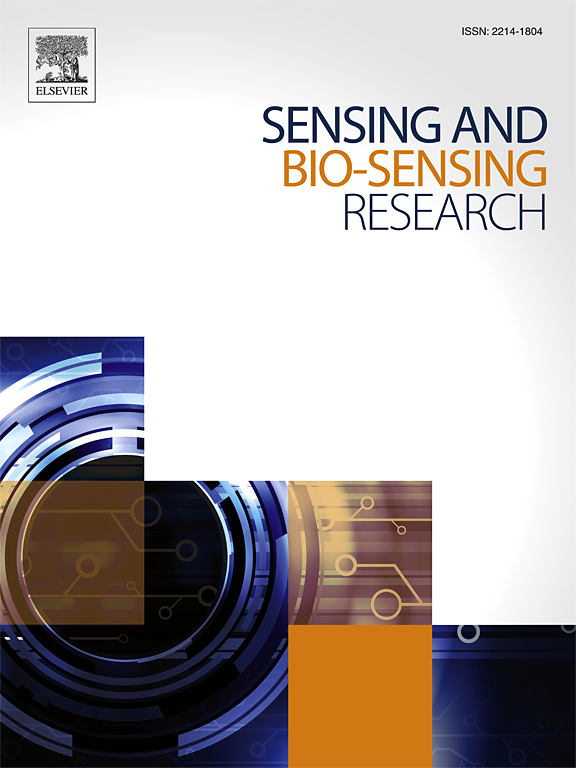Molecularly imprinted polymers-based electrochemical sensors for tracking vitamin B12 released from spray-dried microcapsules during in vitro simulated gastrointestinal digestion
IF 4.9
Q1 CHEMISTRY, ANALYTICAL
引用次数: 0
Abstract
Highly sensitive detection of vitamin B12 (VB12) is crucial for assessing its bioavailability and diagnosing deficiency-related disorders. VB12 with 87.69 % efficiency was microencapsulated by spray drying complex coacervation-based emulsions of Arabic gum and sonicated insect protein, forming 5.4 μm semi-spherical microcapsules with smooth or wrinkled surfaces. The optimized VB12-specific o-aminophenol (AP)-based molecularly imprinted polymer (MIP) film demonstrated efficient molecular recognition and significant electrochemical responsiveness, enabling VB12 detection in PBS buffer with an LOD of 0.5 μM within a linear range of 0.5–10 μM (R2 = 0.991). Surface characterization revealed remarkable property changes during sensor fabrication. A significant reduction in the hydrophilicity of the VB12-AP-MIP film after template removal (TR) was observed due to the increased contact angle from 33.1° to 55.82° (p < 0.05). Morphological analysis using atomic force microscopy (AFM) showed the highest roughness (90.57 nm) for the VB12-AP-MIP film, decreasing after TR (30.56 nm) and increasing upon VB12 capture (46.04 nm). Scanning electron microscopy (SEM) revealed smoother, more uniform surfaces for MIP films than non-imprinted polymer (NIP) films, indicating the template's critical role in polymerization. The developed electro-MIP sensor exhibited good template-selectivity and a 15-day storage stability at 4 °C. The electrochemical VB12-AP-MIP sensor successfully detected VB12 in digested microcapsules under simulated salivary (3.30 ± 0.46 μM), gastric (64.87 ± 2.66 μM), and intestinal (76.68 ± 2.16 μM) conditions. The VB12 analysis using HPLC and UV–Vis spectrophotometry showed that the electro-MIP sensor outcomes were comparable to those obtained with HPLC. The developed electro-MIP sensor would be a promising tool for determining VB12 levels in complex biological samples.
用于跟踪喷雾干燥微胶囊在体外模拟胃肠消化过程中释放的维生素B12的分子印迹聚合物电化学传感器
维生素B12 (VB12)的高灵敏度检测对于评估其生物利用度和诊断缺乏相关疾病至关重要。用阿拉伯胶和昆虫蛋白复合凝聚乳状液进行喷雾干燥,制备出表面光滑或褶皱的5.4 μm半球形微胶囊,微胶囊效率为87.69%。优化后的VB12特异性邻氨基酚(AP)基分子印迹聚合物(MIP)膜具有高效的分子识别和显著的电化学响应性,在0.5 ~ 10 μM的线性范围内,LOD为0.5 μM (R2 = 0.991)。表面表征揭示了传感器制造过程中显著的性能变化。模板去除(TR)后,由于接触角从33.1°增加到55.82°,观察到VB12-AP-MIP膜的亲水性显著降低。0.05)。原子力显微镜(AFM)形态学分析表明,VB12- ap - mip膜的粗糙度最高(90.57 nm),在TR后减小(30.56 nm),在VB12捕获后增大(46.04 nm)。扫描电子显微镜(SEM)显示MIP膜比非印迹聚合物(NIP)膜表面更光滑,更均匀,表明模板在聚合中的关键作用。所开发的电- mip传感器具有良好的模板选择性和在4°C下15天的储存稳定性。电化学VB12- ap - mip传感器在模拟唾液(3.30±0.46 μM)、胃(64.87±2.66 μM)和肠道(76.68±2.16 μM)条件下成功检测了消化微胶囊中的VB12。利用高效液相色谱法和紫外-可见分光光度法对VB12进行分析,结果表明电- mip传感器的结果与高效液相色谱法的结果相当。所开发的电- mip传感器将是测定复杂生物样品中VB12水平的有前途的工具。
本文章由计算机程序翻译,如有差异,请以英文原文为准。
求助全文
约1分钟内获得全文
求助全文
来源期刊

Sensing and Bio-Sensing Research
Engineering-Electrical and Electronic Engineering
CiteScore
10.70
自引率
3.80%
发文量
68
审稿时长
87 days
期刊介绍:
Sensing and Bio-Sensing Research is an open access journal dedicated to the research, design, development, and application of bio-sensing and sensing technologies. The editors will accept research papers, reviews, field trials, and validation studies that are of significant relevance. These submissions should describe new concepts, enhance understanding of the field, or offer insights into the practical application, manufacturing, and commercialization of bio-sensing and sensing technologies.
The journal covers a wide range of topics, including sensing principles and mechanisms, new materials development for transducers and recognition components, fabrication technology, and various types of sensors such as optical, electrochemical, mass-sensitive, gas, biosensors, and more. It also includes environmental, process control, and biomedical applications, signal processing, chemometrics, optoelectronic, mechanical, thermal, and magnetic sensors, as well as interface electronics. Additionally, it covers sensor systems and applications, µTAS (Micro Total Analysis Systems), development of solid-state devices for transducing physical signals, and analytical devices incorporating biological materials.
 求助内容:
求助内容: 应助结果提醒方式:
应助结果提醒方式:


